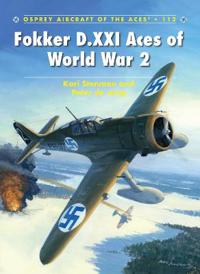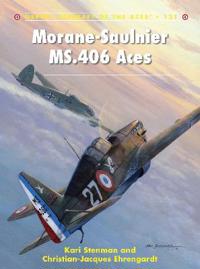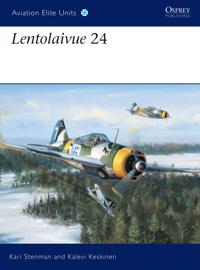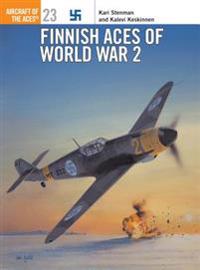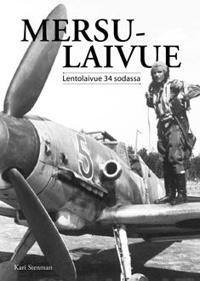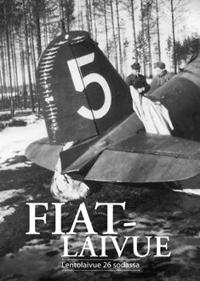Fokker D.XXI Aces of World War 2 (Häftad)
avKari Stenman, Peter de Jong
ISBN: 9781780960623 - UTGIVEN: 201304The Dutch D.XXIs saw less than a week of action following the German invasion of the west on 10 May 1940, with many of the country's 28 fighters being destroyed on the ground. However, those that survived the initial onslaught inflicted losses on the Luftwaffe. By then, however, the D.XXI had found [...]
Morane-Saulnier MS.406 Aces (Pocket)
avChristian-Jacques Ehrengardt, Kari Stenman, Chris (ILT) Davey
ISBN: 9781782003410 - UTGIVEN: 2014-05The MS.406 was an important aircraft not only because it was built in larger numbers than any other French fighter of the period, but also because it was the first modern fighter in the Armee de l'Air inventory. Although comparable to the British Hurricane and early models of the German Bf 109, it w[...]
Lentolaivue 24 (Pocket)
avKari Stenman
ISBN: 9781841762623 - UTGIVEN: 2001-07Finland's premier fighter squadron during World War 2, Lentolaivue 24 (Flying Squadron 24) first saw action during the bloody Winter War of 1939-40, when the Soviet Red Army launched a surprise attack on the small Scandinavian country - the squadron enjoyed great success against numerically superior[...]
Finnish Aces of World War 2 (Pocket)
avKari Stenman
ISBN: 9781855327832 - UTGIVEN: 1999-01In the AIRCRAFT OF THE ACES series, an illustrated aviation history of the Finnish fighter pilots in the Second World War. It includes information on tactics, tables of the units involved and interviews with some of the pilots themselves.[...]
Finnish Fighter Colours (Inbunden)
avKari Stenman
ISBN: 9788363678074 - UTGIVEN: 2014-08This illustrated book covers in-depth the Finnish Fighter aircraft deployed during World War Two. Camouflage and markings of the fighters which were obtained from France, the USA, Germany, the UK and the USSR are described in unparalleled detail by the well-known Finnish aviation expert Kari Stenman[...]
Venäläiset pommittajat (Häftad)
avKalevi Keskinen, Kari Stenman
ISBN: 9789529943272 - UTGIVEN: 2006-01Suomen ilmavoimat 3 (Inbunden)
avKalevi Keskinen, Kari Stenman
ISBN: 9789529974313 - UTGIVEN: 2007-01Suomen ilmavoimat 4 (Inbunden)
avKalevi Keskinen, Kari Stenman
ISBN: 9789529974320 - UTGIVEN: 2007-01This book Finnish Air Force IV is the fourth volume of a series covering the phases of the Finnish air arm. This volume deals with 1942, the first stalemate year of the Continuation War. The focus is in Finland's attempt to keep the air superiority against the increasing Soviet air forces.The main t[...]
Suomen ilmavoimat 5 (Inbunden)
avKalevi Keskinen, Kari Stenman
ISBN: 9789529974337 - UTGIVEN: 2008-01Mersulaivue (Inbunden)
avKari Stenman
ISBN: 9789529974375 - UTGIVEN: 2012Pääteksti käsittää myös lyhyen kuvauksen samannumeroisista laivueista. Teoksen pääpaino on kolmannessa Lentolaivue 34:ssä, joka soti Messerschmitteillä. Jatkosodan jälkipuolisko käsitellään kronologisesti/operaatioittain ja esitys päättyy laivueen numeron muutokseen 4.12.44 sekä lyh[...]
Fiat-laivue (Inbunden)
avKari Stenman
ISBN: 9789529974382 - UTGIVEN: 2013Pääteksti käsittää myös lyhyen kuvauksen laivueen alkuvaiheista. Teoksen pääpaino on talvi- ja jatkosodissa, jotka käsitellään kronologisesti/operaatioittain ja esitys päättyy laivueen numeron muutokseen 4.12.44 sekä lyhyeen jälkihistoriaan.Sotapäiväkirjanomaista esitystä on täyde[...]

